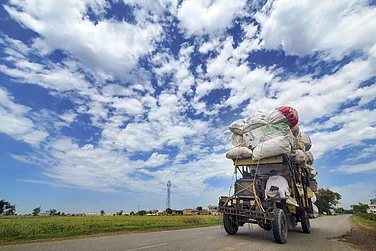Anandji had tried hard but was unable to find me a room in a guest house or a hotel. Maybe I was paying the price for being Indian.
Wherever we went, the person at the reception would shake their head after looking at me: “We do not have rooms.” They had no time left after dealing with foreigners. In fact, almost all the guest houses and hotels on the streets near the Ganga were filled with foreign tourists.
I had just about lost hope. It seemed like my wish to stay close to the ghats (riverbanks)would not be fulfilled. However, Anandji held on to hope and helped me navigate a maze of alleys to reach the ornately carved wooden door of a three-storey mansion. Leaving me to wait at the door, he went in.
Anandji came out after a while. My stay had been arranged. I found out that this was a haveli (mansion) owned by a friend of his. He had converted the top floor of the building into a guest house that was used by both Indian and foreign tourists. I put my luggage down in a vacant room, tired after a busy day of moving around on foot. It was already late and Anandji had to return home. I thanked him for arranging the room and said goodbye.
The room had a beautiful mahogany bed. I had a careful look around after sitting down. It was a large room with two large doors. The second door opened towards the street. The interiors of the room spoke of the opulent past of the haveli’s owner. There were few people out on the street by now and the constant sound of temple bells ringing had stopped.
The identity of any ancient city lies in its old quarters. The city’s soul resides in the old buildings and alleys. And if the city is Banaras, this is more true. I started thinking about the city as I lay on my bed.
I had reached Banaras that morning. The Varanasi Cantt. station, where I had alighted from the train, is in the new part of the city. This looks like any other city, with new buildings, malls, huge shops and rows of new, swanky cars on the road. This is not the Banaras that I had come looking for. I was seeking the ancient Banaras that lives in its narrow alleys, ghats and old neighbourhoods.
Banaras represents India in religiosity and intellect just like Paris symbolises the French psyche. There are few cities in the world known for their antiquity. Even among them, none has preserved their fame and singularity like Banaras. Patna, or Patliputra, is also an ancient city but it does not possess the continuity that Banaras boasts of.
Here, I cannot help but recall Mark Twain, who had said: “Banaras is older than history, older than tradition, older even than legend, and looks twice as old as all of them put together.”
It was in Banaras—Sarnath, to be exact—that Buddhism was first professed. As for Hinduism, it has been its spiritual home. Thus, this city has given spirit and vitality to two great religions which now guide almost half of the world’s population.
Lost in such thoughts, I do not remember when I fell asleep. The next morning, Banaras had woken up before me. Morning here begins early. I came out from the haveli onto the street. Winter was about to end but the morning still had a thick mist. On the street, people could be seen heading to the ghats. They were walking rapidly towards the riverbank while chanting mantras and greeting each other. I was staying on a street called ‘Tedhi Neem’. The Dashashwamedh ghat was not far from there. I also joined the people going to the ghat.
The ghats of Banaras are famous all over the world for their unique features. They have always been a source of attraction for foreign tourists. Therefore, I was not surprised to see foreigners there so early in the misty morning. I sat down on the ghat’s steps and the unending waters of the Ganga lay before me. In the distant horizon, the sun slowly rose from the waters. Like a slowly burning candle, it melted over the white February mist. In the pale light of the morning, one could see the huddle of people taking a dip in the Ganga.

I wondered if for centuries people must have been taking a dip in the Ganga with equal devotion. Why does the Hindu psyche connect so deeply with the Ganga? I am reminded of the words of famous Hindi author, Nirmal Verma, who wrote, “Is Ganga just some flowing water for an Indian? It awakens our deepest memories—which we call Sanskar—and takes us into that mythological moment in history when the tired Aryans must have first seen this free, smooth stream. This is such a strange contradiction: that after a while, man-made buildings turn into nature, lapsing into the evening sun, free of history; while generations of bathing travellers have imbibed the eternal flow of the Ganga in their memories— as history and nature have become one.”
Verma adds, “Old monuments and ruins make us conscious of the death that we carry within us. The flowing water reminds us of the life that is present, mobile and endless, despite its death. When a Hindu floats the ashes of his loved ones in the Ganga at Haridwar, not only does he release the soul from its body, he also frees himself of the pain.”
Suddenly, I saw Anandji. He was conducting a puja (ritual prayer) for a yajman (client). The previous day, I had met him by chance while meandering through the alleys of Banaras. These alleys are astonishing. Alleyways exist in most cities of the world but the ones in Banaras are unique due to their structure. They have been formed by the construction of rows of massive buildings. They are one to two metres wide and slope down towards the Ganga. All the alleys are paved with stones or bricks. They have underground drains that carry dirty water opening into the Ganga.
Walking around here, I cannot help thinking of the British priest, Bishop Reginald Heber, who had come to Banaras in the early 19th century and stayed here for many years. In his memoir titled Narrative of a Journey through the Upper Provinces of India, from Calcutta to Bombay, Heber calls Banaras a “very remarkable city, more entirely and characteristically eastern than any which I have yet seen and at the same time altogether different from anything in Bengal. No Europeans live in the town, nor are the streets wide enough for a wheel-carriage. The houses are mostly lofty, none I think less than two stories, most of three, and several of five or six, a sight which I now, for the first time, see in India.”
Heber describes the city’s temples in minute detail: “The number of temples is great, mostly small and stuck like shrines in the angles of the streets and under the shadow of lofty houses. Their forms, however, are not ungraceful, and they are many of them entirely covered over with beautiful and elaborate carvings of flowers, animals, and palm branches, equalling in minuteness and richness the best specimens that I have seen of Gothic or Grecian architecture.”
Although nearly 200 years have passed since the memoir was written, I was amazed to see that the streets and the houses and temples inside them are almost the same as described by Heber. It was in such a house with floral carvings that I saw Anandji standing at the door. I was attracted by the main door of his house and started clicking pictures. Later, I spent a long evening exploring the streets of Banaras with him.
Anandji had finished his pooja. He was gathering the objects he had received as dakshina (the offerings to the priest). He appeared very happy; the day had begun well for him. We sat down at a teashop on the ghat, where two to three customers were already seated. One of them was a foreign woman from a European country. Her face broke into a smile of recognition upon seeing Anandji: they knew each other. We sat with our tea and Anandji told me about her. She was a French woman named Marie Pierre, who now called herself Yogmaya. A painter and singer by profession, for the last few months she had been living in a rented room at a house near the ghat and spent her days on the ghat, in temples and the alleys. What was this quest in her? I looked at her curiously, even as she was immersed in her tea.
The woman was blonde and good-looking. Her name reminded me of Marie Antoinette, the infamous French queen, who is associated with and remembered for the proclamation: “If they don’t have bread, let them eat cake!” History has been very unkind to her. Marie Antoinette was an unparalleled beauty and a sensitive woman. She did a lot to help the poor people of France but her opponents were very resourceful. That is why she was always surrounded by rumours. When the people of France revolted against King Louis XVI, they readily believed that the queen must have uttered that infamous line.
On 16 October, 1793, when Marie Antoinette was executed by guillotine, she was just 38 years old. Even under such adverse circumstances, she maintained the composure expected of an empress, in spite of having lost her two children to disease and her husband to the guillotine.
The sun had begun climbing up in the sky. Anandji bid adieu to me, as he had to go somewhere. I stayed back at the ghat. Banaras has a long line of ghats, spread from Assi ghat to Varuna Sangam ghat. Some of the important ghats include the Tulsi, Harishchandra, Hanuman, Mansarovar, Darbhanga, Dashashwamedh, Prayag, Man Mandir, Mir, Nepali, Lalita, Manikarnika, Panch-Ganga, Venimadhav and Raj ghat. Renowned historian Moti Chandra writes in his book, Kashi Ka Itihas (The History of Kashi): “In the mid-18th century, the Marathas built several ghats in Banaras. Manikarnika ghat was completed in 1730 AD. Several ghats such as Brahma ghat and Durga ghat were constructed after that. Ghats continued to be built even after the Peshwas lost their connection with Banaras.”
The British painter William Hodges was probably the first person to sketch the ghats. He visited Banaras in 1781 and his paintings stoked a lot of curiosity and interest in the city back in Britain. Lord Valentia, who arrived in Banaras in 1803, described the ghats in a way that holds true even today. He says that there were innumerable small and large temples by the river. Many of them descend down to the ghats. The temples are made of stone and are so strong that they can withstand the powerful current of the Ganga during the rainy season. Some temples carry brilliant paintings, while others are plain. They often carry a trishul (trident) on the top. The ghats have been built for people to bathe. The paintings of the ghats that he had seen earlier were a mere shadow of this unique scene, he says.
James Prinsep, the British antiquary who first deciphered the Brahmi and Kharosthi scripts, was also the first person to publish an illustrated book on Banaras, similar to today’s coffee-table books. A few years later, MA Sherring came to Banaras, in 1868, and went on to make numerous sketches of the city and write a brilliant book on it.
Moti Chandra writes that “there is no doubt that Banaras had gained fame as a popular site of pilgrimage. It started being counted among the holy trio, along with Gaya and Prayag. The holy status of Kashi resulted in Hindu travellers from all over India bearing all kind of hardships to reach here. Many religious Hindus even decided to settle here in the quest for moksha (liberation).”
Chandra adds that “until the 19th century, there was even a tradition of drowning oneself in the Ganga to attain nirvana. Those wishing to die in this way would tie two pots to themselves and venture far into the river, eventually drowning when the pots got filled with water. The British tried hard to stop this tradition.”
By this time, people had started returning; the ghat was emptying. Pilgrims, widows from the ashram, old men on their deathbed, and locals—everyone was carrying their wet clothes, towels and lotas (small vessels) filled with Gangajal, the holy water of the Ganga. Gangajal is a must-have for any Hindu household. I ask myself: would I be able to drink it, my eyes wandering to the filth spread over the ghats. Just a little away from where I sat, a massive drain was constantly emptying dirty water into the Ganga. All the polluted water from the city drains ends up in the river. Not just Banaras, all the cities on the banks of Ganga release their filth into it.
Years ago, when Icelandic Nobel Literature Laureate Halldór Laxness visited Banaras, he was astonished to know that people come not just to bathe in the Ganga but also to wash their sins. In a discussion with Verma in Reykjavik, he said, “The Ganga’s waters in Varanasi cannot be termed very clean. A guide from the Varanasi municipality—who was well educated, with an MA in Literature—told me that people do not come to the Ganga to bathe, but to wash their sins. He also said that there are no germs in the water. I was amazed to know that he himself believed in this thing: not the claim about germs, but about people’s sins...I don’t know, but it seems like Indians do not believe much in germs anyway.”
Where do I stand? I ask myself. Am I one of those who lets themselves be carried away in the torrent of blind devotion, or among those who stand on the shore and watch others being carried away?
The day had progressed and I was beginning to feel hungry. I left the ghat and entered the alleys. The streets of Banaras are incredible. They surprise you at each step. I have memories from here dating back several years. At the time, one could find shops selling kachoris, jalebi, rabri, malai etc, along with some establishments selling idlis and dosas. These have survived. However, this time I was amazed to discover restaurants offering authentic Japanese, Korean and Chinese cuisine. The people running them were also from these countries. I entered a Korean restaurant. The tables were full of foreign tourists, probably Koreans and Japanese, who could only speak a little English and no Hindi. I ordered sushi and kimchi for myself, along with fried eggs. I followed that up with their special tea.
At the street corner, I ran into Marie again and stopped. She recognised me. I was curious about her and wanted to know more. She was headed to the Dashashwamedh ghat. I joined her.
“Five years ago, one day I suddenly decided to go to India. I had no plans and did not know any particular place here. I just bought an air ticket to Delhi and landed there,” she told me.
“But why India?” I asked.
“Because I believe in India. I can feel it. Maybe it is the impact of my past lives.”
“Do you believe in rebirth?”
“Yes, why not? You will find many people in the West who believe in it,” said Marie, who was from Saint-Cloud, a northern suburb of Paris situated on the banks of the Seine. Born to teacher parents, Marie grew up to be a painter and professional singer. She was doing well for herself but had constantly found herself mired in a nameless, inexplicable unrest.
“I was unable to understand what it was. Once I was in Italy for my painting exhibition and concerts. There, a friend told me about India. She said ‘Go there! You will really like it.’ Even earlier, many people in France had told me about India. I felt like an inner voice was telling me to go to India, so I came here. I kept travelling, from the north to the south, from east to west, to know and understand this land. But not just as a tourist. Then someone told me about Banaras. Then someone else said: ‘Do not go to Banaras, it is dirty and crowded. There are many local and foreign tourists.’ But I thought, let’s give it a go.”
“I got down at the Varanasi Cantt. station, and did not like anything there. But as soon as I came here and entered Vishwanath street, I was mesmerised.” (Even as I pen this down, Vishwanath street is no longer the same that had once mesmerised Marie. The drive to turn Banaras into Tokyo and Osaka has completely destroyed its original form.)
She continued: “It was as if a river of joy started flowing over me. Such happiness, such exhilaration I had felt only as a child. I felt that this was my home. Since then, I started living here. After a month, I threw away my shoes.”
I listened to her, spellbound. Her eyes, which carried both compassion and affection, were staring somewhere in the distance, into the nothingness on the other side of the Ganga. I looked at her shoeless feet. Is this devotion, then? I asked myself. In that moment of wonder, I was reminded of Nirmal (Verma) again. He writes, “A person who looks from the outside can only see the outer layer but the outer layer is connected to the underlying meaning—if we cut superstition with a pair of scissors, we would also end up uprooting the meaning of true faith.”
Darkness was descending on the ghat. Preparations were on for the maha-aarti (grand prayer). Devotees, local and foreign tourists had begun gathering to watch it. All of them had found a place on the steps of the ghat. A dense silence spread all around. The maha-aarti began, and its light and the sound of bells soon overpowered the surroundings.
Translated from Hindi by Iqbal Abhimanyu
(Views expressed are personal)
Arun Singh is a patna-based Independent journalist























